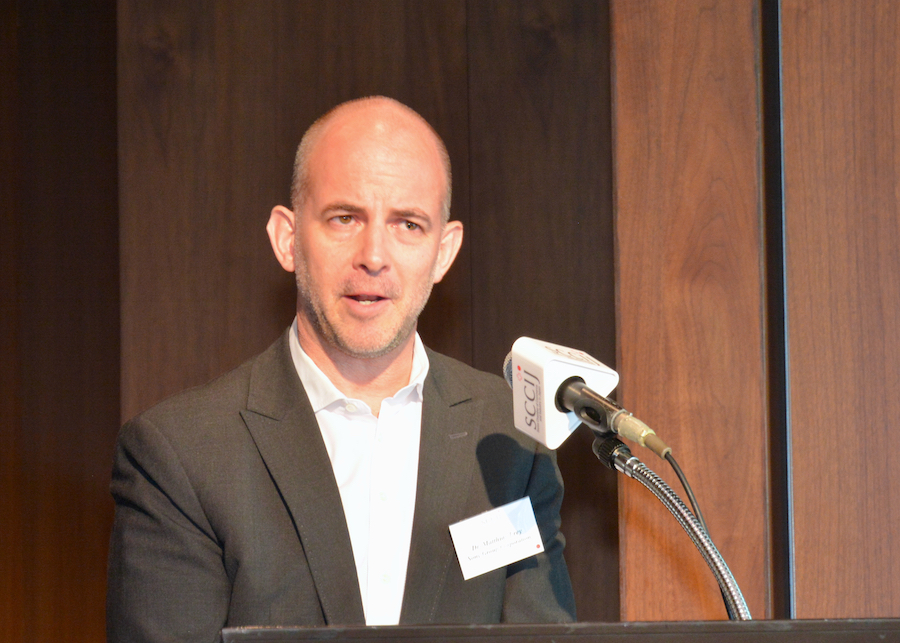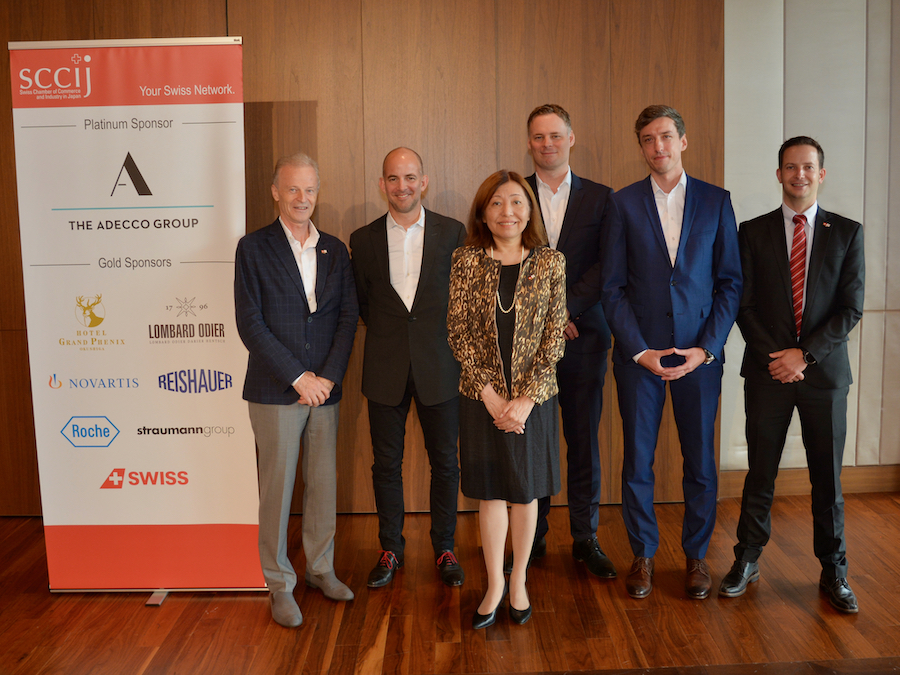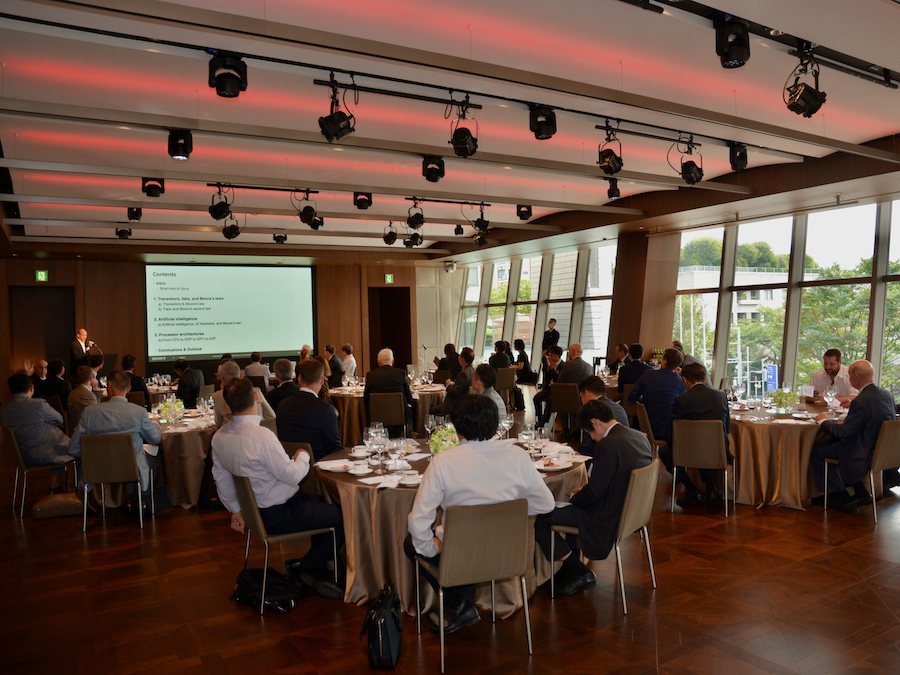Tokyo (SCCIJ) – At the September Luncheon, Matthias Frey, Strategy Planning Manager at Sony Group Corporation, gave an overview of the current state of the semiconductor industry. In particular, he explained how an increasing complexity and other factors led to the current scarcity of processors and semiconductors in general. We summarize his talk in interview format.

September Luncheon speaker Matthias Frey, Strategy Planning Manager at Sony.
It is said ‘What oil was in the 20th century, are chips in this century’. How relevant is the semiconductor industry?
Mr. Matthias Frey: In 2021, the global semiconductor industry had sales of $556 billion. It grew by an astonishing 26%. Still, it is poised for a decade of growth and is projected to become a trillion-dollar industry by 2030.
How dependent has the world economy become on semiconductors?
M. Frey: Estimates show that “the average Westerner” encounters about 2,000 chips every day. Furthermore, according to McKinsey, there are now roughly 1,000 chips in a non-electric vehicle and up to 3’500 in an electric one.
The famous Moore’s law says that the number of transistors on a microchip doubles every two years. How long can this go on?
M. Frey: We are currently reaching the physical limits of Moore’s law. The current state-of-the-art technology is a process node size of around 5 nanometers – human hair is much thicker with 80,000 to 100,000 nanometers. The diameter of a silicon atom is ~0.2 nm and at least several atoms are required to create a transistor. This means we are nearing the end of Moore’s law.
How about Moore's second law, also known as Rock's law, that the cost of a semiconductor chip fabrication plant doubles every four years?
M. Frey: The manufacturing of chips is a very complex and costly process; currently both complexity and prices are increasing. The planned 5-nanometer chip factory (fab) of market leader TSMC from Taiwan with a capacity of 20,000 wafers per month is estimated to cost $12 billion. For modern nodes, fabrication can take up to 15 weeks, with 12 weeks being the industry average. Only the cost of one transistor goes down.

Members and advisors of the SCCIJ executive committee with September Luncheon speaker Matthias Frey.
There is fierce global competition now for semiconductor plants. What are the reasons?
M. Frey: The semiconductor industry is a global, extremely interconnected system. Chip production moved away from Japan, Europe, and the U.S. to Taiwan and South Korea. But ubiquitous semiconductors have become the most important asset, the “oil” of the 21st century. The European automotive industry lost production of 11 million cars due to chip scarcity. But despite the “chip acts” in the U.S. and Europe, there is no simple solution because new fabs need four, or five years to build.
But what are the causes of this scarcity?
M. Frey: The industry itself is very cyclical with strong ups and downs in investments, prices, production, demand, and technology upgrades. However, I do think that this current cycle is more severe than in the past. At the beginning of the pandemic, the automotive industry placed fewer orders and the semiconductor makers shifted to producing more for consumer electronics. Furthermore, there was a massive fire at a Japanese chip plant, electricity outages in Texas for chip plants due to a strong winter, and a container ship stuck in the Suez Canal.

An impression of the SCCIJ September Luncheon.
When will we overcome this period of scarcity?
M. Frey: Shortages will not go away before mid of next year, I think. But the whole chip industry has committed itself to increasing output capacity at an unprecedented level. Capital expenditures from the three largest players will likely exceed $200 billion from 2021 to 2023 and could reach $400 billion by 2025. Governments have committed hundreds of billions more. Nevertheless, due to the complexity and the cost, ramping up takes time. For example, there are not enough semiconductor specialists and engineers to satisfy demand.
We also observe strong growth in artificial intelligence applications. How is this trend influencing the semiconductor industry?
M. Frey: What we understand as Artificial intelligence today is mainly “deep learning”. The corresponding algorithms require a massive amount of computing power and vast amounts of data, for example for natural language processing. To efficiently train deep learning networks, generalized processors (CPUs or GPUs) are not ideal but specialized processors are required. Often, different processors are combined on a single chip to handle different tasks efficiently. Due to this “golden age of processors”, we observe a verticalization of the industry, with companies like Apple, Amazon, Baidu, Google, and Tesla designing processors for their specific purposes.
Biography of the speaker
Matthias Frey received his Ph.D. in signal processing and analog chip design from ETH Zurich in 2006. He subsequently held various R&D positions in the Japanese industry, developing analog-digital converters, laser distance measurement algorithms, and ultra-sonic speakers. From 2012-2017, Matthias headed the Science & Technology Office Tokyo of the Embassy of Switzerland in Japan. Since 2018 he has been Chief Analyst at Sony Europe, specializing in semiconductors, signal processing, and machine learning. Earlier this year, he joined Sony’s Corporate Technology Strategy Division as Strategic Planning Manager in the domain of System on Chips and semiconductors.
Text and photos: Martin Fritz for SCCIJ





























